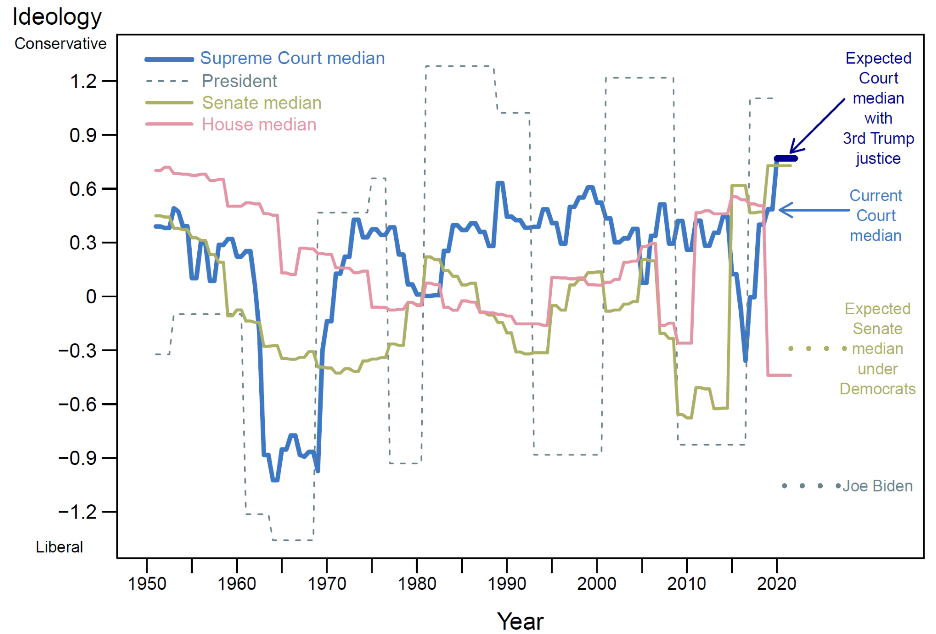The death of Supreme Court Justice Ruth Bader Ginsburg gives President Trump an opportunity to shift the ideological tenor of the court. If the Senate were to confirm a Trump nominee, the court would become more conservative than it has been since 1950 — both more conservative than previous courts, and potentially as far away ideologically from the elected branches of government as it has been in a long time.
So just how conservative could the court become?
Here’s how I did my research
I created a statistical model to estimate the ideological views of justices, presidents and members of Congress. For justices, I used information from their votes on cases and opinions, which tell us how their ideologies compare to those of the other justices. Their opinions on previous cases reveal how their ideological positions compared to those of members of the previous courts that decided those earlier cases.
For members of Congress, I used their floor roll call votes to estimate how each one’s ideology compares to the ideologies of their colleagues. I also used the positions members of Congress take on Supreme Court cases to compare their ideologies to those of the justices. I estimated those positions based on statements they made in amicus briefs, on the floor of Congress and, increasingly, on Twitter.
Similarly, I estimated presidents’ ideological positions as compared to those taken by both the court and Congress from their public positions on congressional roll call votes and statements and amicus filings on court cases.
Using these measures, I could compare the ideological tenor of each branch of the federal government with that of its counterparts from 1950 to the present.
Presidential ideologies tend to stake out either the liberal or the conservative extreme. I estimated House and Senate ideologies as the positions of the median member. Those bodies’ ideologies are generally closer to the middle, shifting when a different party controls the chamber.
I measured the Supreme Court’s ideology with the court’s ideological median at any given time. While very liberal during the Warren Court from 1953 to 1969, the court median has hovered on the center right since the mid-1970s, except for a brief liberal interlude after Justice Antonin Scalia’s death in February 2016 until Neil M. Gorsuch filled that seat in early 2017.
Identity politics can help Biden win in November
A third Trump nominee would make the court more conservative
On the right side of the figure, you can see the expected court median that would result if, as expected, Trump’s eventual nominee is confirmed to the court. As you can see, not only would the court median become substantially more conservative than it is today, it would become the most conservative court across the entire measured period.

The court could also be further ideologically from the other branches than it has been before
The court could also be more conservative than the elected branches to a degree not seen in 70 years. Given the high probability that Democrats will retain control of the House, the expected court median is likely to be vastly more conservative than the House median.
The expected court median would also be to the right of the current Senate. If the Democrats were to win control, the Senate median would shift at least to -0.29 (the estimated ideological position of Sen. Doug Jones from Alabama) and possibly even further in a liberal direction.
And, of course, if Democratic candidate Joe Biden wins the presidential election, the presidency’s ideological leanings would shift dramatically toward the liberal end. In this figure, I indicated Biden’s expected ideology as president using his estimated ideology as a senator in 2008, before he became vice president.
If Democrats win the presidency, House and Senate, the gap between the court median and these elected branches would be the largest since 1950, potentially setting up bruising battles over court expansion and other means by which the political branches may seek to offset court power.
Here’s what Pelosi could do if Republicans tried to manipulate the election’s outcome
5-to-4 decisions could become less likely
When conservatives have only a bare majority on the court, as they currently do, the liberal side can win by pulling only one conservative justice to their side. That happened, for example, in June Medical Services v. Russo, when Chief Justice John G. Roberts Jr. sided with the liberals in a case about a restrictive Louisiana abortion law, writing that he did so out of respect for court precedent. But if there are six conservative justices, liberals would have to win over two justices to prevail, a more remote possibility.
The figure below shows the estimated ideological positions of the eight remaining justices — with that of a ninth hypothetical justice whose ideology lands between that of Gorsuch and Samuel A. Alito Jr. Note the large gap in the ideological middle. That gap would make it less likely that liberals could find a five-vote majority on a case contested between left and right, reinforcing the likelihood that the court will rule in a conservative direction.

These potential shifts in the court from Trump’s third nominee would give the country a historically conservative court to grapple with such hotly contested issues as abortion, elections, labor law, health care, government regulation, the environment and more. If the Democrats were to gain control of the Senate and White House in the November elections, such a court would regularly clash with the other branches of government. The outcome of those battles may set policy for many years to come.
Don’t miss any of TMC’s smart analysis! Sign up here for our newsletter.
Michael A. Bailey is a professor at Georgetown University, where he directs the McCourt School’s Massive Data Institute and its Data Science for Public Policy program, and is co-author with Forrest Maltzman of “The Constrained Court: Law, Politics and the Decisions Justices Make” (Princeton University Press, 2012).



